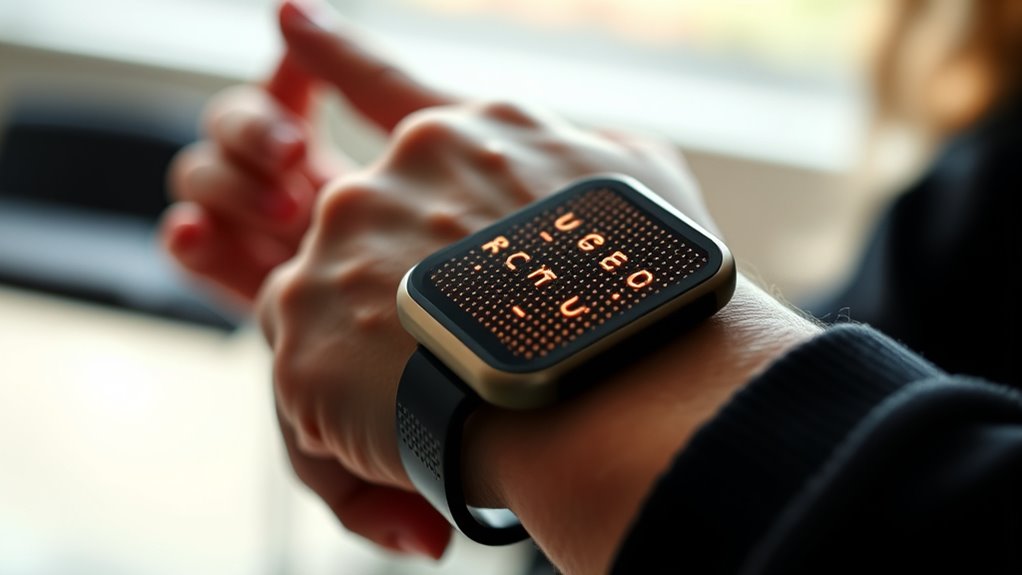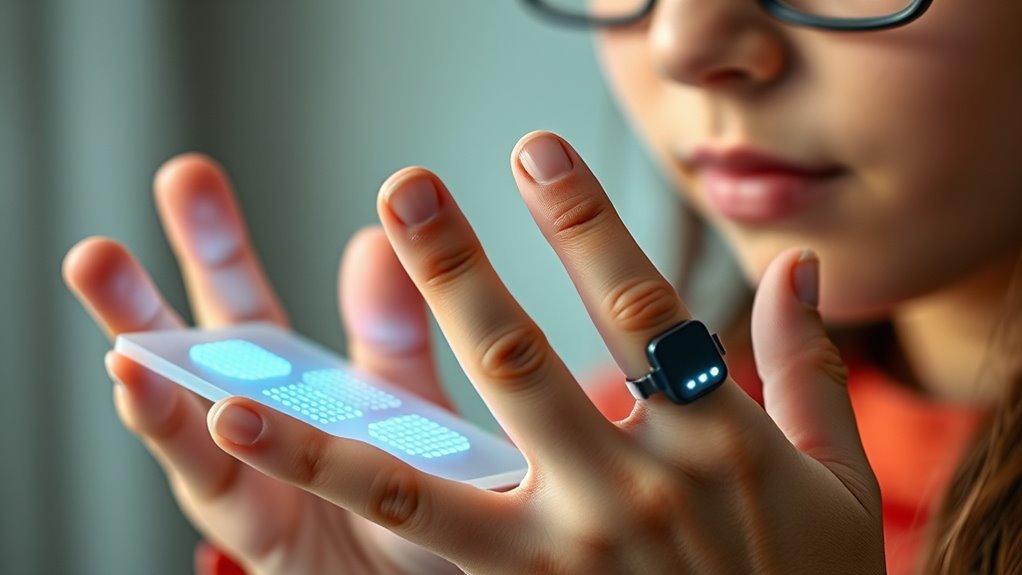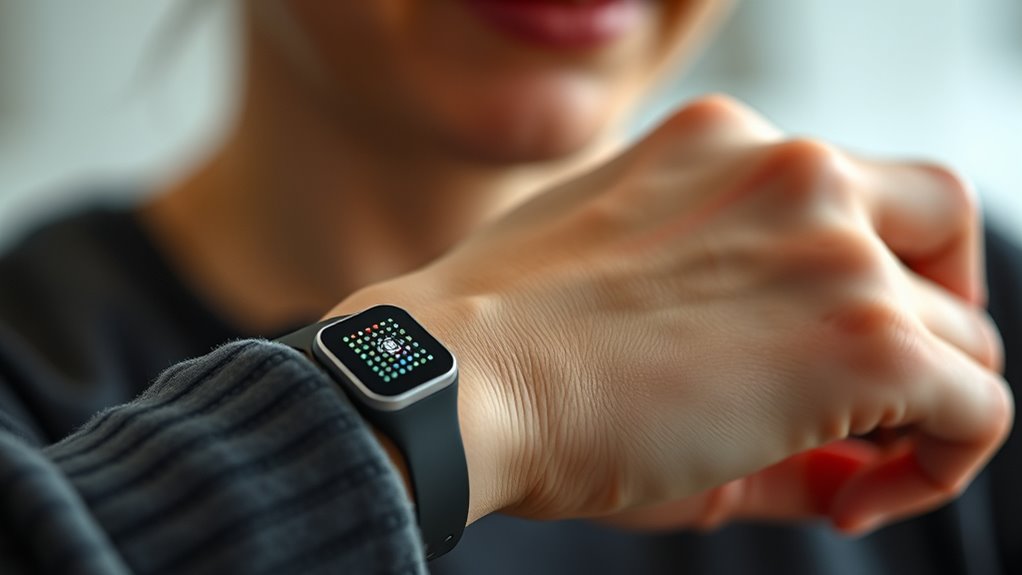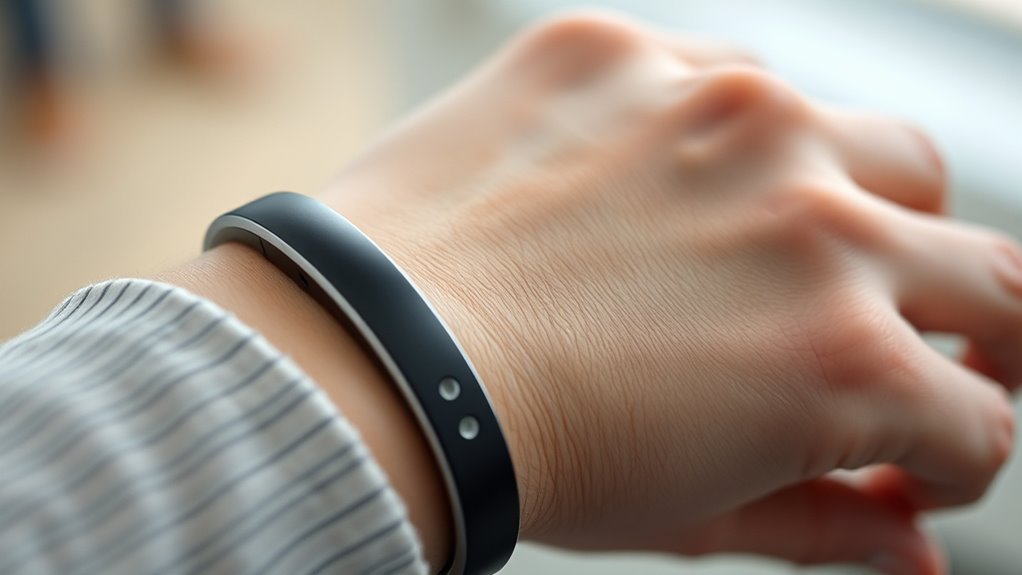Wearable tech now helps you communicate better by translating sign language into tactile signals or Braille-like feedback in real-time. Using sensors, AI, and haptic feedback, these devices recognize gestures and facial expressions instantly, converting them into sensations you can feel or tactile stimuli. They’re designed to be discreet, comfortable, and secure, making everyday interactions easier. If you want to discover how these innovative devices work and improve your daily life, keep exploring the possibilities.
Key Takeaways
- Wearable devices utilize sensors and AI to detect sign language gestures and convert them into tactile signals or Braille-like sensations for deafblind users.
- These technologies enable real-time translation of visual signs into tactile stimuli, enhancing immediate understanding and communication.
- Designed for comfort and discretion, wearable tech integrates seamlessly into daily activities, promoting independence and social engagement.
- Advanced security features ensure privacy and protection of sensitive user data during sign language translation processes.
- Future innovations focus on miniaturization, personalized feedback, and adaptive algorithms to improve accuracy, responsiveness, and user experience.
The Technology Behind Sign-to-Braille Wearables

The technology behind sign-to-Braille wearables combines advanced sensors, artificial intelligence, and haptic feedback to convert visual sign language into tactile stimuli. When you perform gestures, sensors detect your hand movements and interpret them through sophisticated gesture recognition algorithms. This process guarantees that each sign is accurately identified in real-time. The device then uses haptic feedback to deliver tactile signals directly to your fingertips, translating gestures into meaningful Braille-like sensations. This seamless conversion depends on sensor calibration and AI-driven processing, enabling you to understand sign language without needing visual cues. Additionally, the system can utilize various material-based tactile stimuli to enhance the sensory experience and improve comprehension. Incorporating personalized feedback further refines the tactile signals, making communication clearer and more intuitive for users. The system’s adaptability is enhanced by ongoing sensor adjustments that optimize performance for individual users, ensuring a comfortable and effective communication experience. Recognizing the importance of mindfulness in sensory integration, the system is designed to adapt to individual preferences, ensuring a comfortable and effective communication experience. The integration of gesture recognition and haptic feedback creates an intuitive system that bridges communication gaps, making sign language accessible to deafblind users through a wearable, tactile interface.
How These Devices Enhance Communication for Deafblind Individuals

Wearable sign-to-Braille devices substantially improve communication for deafblind individuals by transforming visual gestures into tactile signals they can feel and interpret instantly. Haptic feedback plays a key role, delivering precise vibrations that mimic sign language movements directly to your fingertips. This immediate tactile response helps you understand conversations without delay, fostering more natural interactions. Additionally, device ergonomics ensure comfort during extended use, allowing you to wear the device throughout the day without discomfort. The intuitive design makes it easier to focus on communication rather than managing the device. As a result, these innovations help you engage more confidently with others, reducing social isolation and promoting independence. By translating gestures into tactile signals seamlessly, these devices considerably enhance your ability to connect with the world around you. The use of advanced projector technology concepts ensures these devices can deliver accurate and consistent tactile representations, improving overall communication effectiveness. Incorporating tactile feedback mechanisms further refines the user experience, making the sensations more lifelike and easier to interpret. Moreover, understanding the importance of safe sleep environments can be crucial for users who rely heavily on wearable devices, ensuring comfort and safety during extended periods of use. Incorporating space and organization strategies can also help in managing device accessories and maintaining a clutter-free environment, making daily use more efficient.
Key Features and Functionality of Modern Sign Language Translators

Modern sign language translators incorporate advanced sensors and algorithms to accurately detect and interpret gestures in real time. You’ll notice how gesture recognition technology captures hand movements and facial expressions with high precision, ensuring smooth translation. These devices process gestures instantly, converting them into spoken words or tactile signals. Haptic feedback is a key feature, providing tactile cues through vibrations or taps, so you can feel the translated message directly on your skin. This real-time interaction makes communication more natural and immediate. The combination of sensors, sophisticated algorithms, and haptic feedback creates a seamless experience, allowing you to understand sign language without delay. Additionally, ongoing research into AI security vulnerabilities highlights the importance of robust safety measures in developing reliable assistive technologies. These features make modern sign language translators powerful tools for bridging communication gaps for deafblind users, especially as cyber threats continue to evolve and challenge device security. Incorporating sensor technology further enhances the accuracy and responsiveness of these translation devices, ensuring more effective communication.
Impact on Daily Life and Social Interaction

By translating sign language into tactile signals, this technology considerably enhances daily life and social interactions for deafblind individuals. It fosters independence, allowing you to communicate more easily in public and social settings. Empowering communication can help bridge social gaps and reduce feelings of isolation. Moreover, the integration of assistive technology into everyday life is crucial for maximizing its benefits and ensuring user acceptance. As the technology evolves, it may also promote universal accessibility, making communication tools more inclusive for all users. However, privacy concerns may arise, as sensitive conversations could be overheard or misinterpreted. Additionally, affordability barriers might prevent widespread adoption, limiting access for many who need it most. To highlight these aspects, consider this table:
| Benefits | Challenges |
|---|---|
| Increased independence | Privacy concerns |
| Better social engagement | Affordability barriers |
| Enhanced communication | Limited access for some users |
| Greater inclusion | Potential reliance on technology |
| Improved quality of life | Maintenance costs |
Future Developments and Potential Innovations

As technology continues to advance, future developments in sign language translation devices are poised to become more seamless, accurate, and user-friendly. Expect improvements in haptic feedback, making tactile signals clearer and more intuitive for users. Devices may incorporate adaptive algorithms that better understand context and individual preferences, enhancing communication speed and reliability. Innovations could also include miniaturized sensors and wireless connectivity, reducing bulk and increasing mobility. Additionally, integrating sleep and mental health considerations can improve device comfort and reduce user fatigue during prolonged use. Moreover, addressing user privacy will be crucial as these devices handle sensitive data, necessitating robust security measures. Developers will likely implement stronger encryption and privacy protocols to protect sensitive information. Furthermore, ongoing research into haptic technology will continue to refine how tactile signals are delivered, making interactions more natural and effective. For example, advancements in wearable tech can lead to more discreet and comfortable devices, further empowering users. Additionally, considering user-centered design principles can ensure that these devices are tailored to diverse user needs and preferences. Overall, these innovations will aim to empower deafblind users with more natural, discreet, and secure ways to connect with the world around them.
Frequently Asked Questions
How Accurate Is the Translation From Sign Language to Braille?
You might wonder about the translation accuracy and device reliability of such tech. Generally, these devices are improving rapidly, providing fairly accurate translations of sign language into braille. However, their reliability can vary depending on factors like lighting, background noise, and user familiarity. While they’re promising tools, it’s important to remember that current technology still has some limitations, and perfect accuracy isn’t guaranteed yet.
Are These Wearable Devices Affordable for Most Users?
You might wonder if these wearable devices are affordable, given pricing concerns and accessibility barriers. While prices vary, many companies are working to make the technology more reachable by offering lower-cost options or assistance programs. However, affordability can still be an issue for some users. It’s important to stay informed about available resources and potential discounts to ensure more people can benefit from this innovative technology.
What Is the Battery Life of These Sign-To-Braille Wearables?
Oh, the joy of seamless power management! You might think these devices last forever, but their battery longevity varies, often needing daily charging. While some models boast a few hours of use, others can stretch to a full day with careful management. So, if you’re counting on them for all-day communication, be prepared to keep an eye on power levels and recharge frequently—because even tech needs a break.
Can the Devices Be Customized for Different Languages or Dialects?
You can customize these devices for different languages and dialects through multilingual customization features. They often include dialect recognition, allowing the device to adapt to regional speech variations. This means you get more accurate translations tailored to your specific language or dialect. As a user, you’ll find these options user-friendly, making communication smoother regardless of your language background or regional dialect, ensuring a more inclusive experience.
How Do Users Adapt to New Wearable Technology Initially?
Imagine holding a new device, its sensors gently resting against your skin, as you first explore its functions. You face a learning curve, feeling both curiosity and uncertainty as you adapt. User acceptance grows as you practice, discovering how the tech translates signals into meaningful sensations. Over time, confidence builds, and what once felt unfamiliar becomes intuitive. Your adaptation journey transforms initial hesitation into seamless integration.
Conclusion
As wearable tech transforms sign language into braille, you gain newfound independence, bridging gaps that once seemed insurmountable. While these devices open doors to clearer communication, they also remind you of the ongoing journey toward full inclusion. In a world where silence and darkness often hide stories, these innovations serve as beacons of hope—proof that technology can turn barriers into bridges, empowering you to connect more deeply with those around you.











